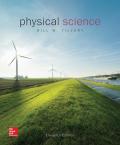
Concept explainers
To complete: From the following options, an empirical formula does not:
identify elements in a compound.
identify actual numbers of atoms in a molecule.
provide the simplest whole number ratio of atoms ofelements with subscripts.
provide the formula for an ionic compound.
Answer to Problem 1AC
Solution:
Option (b) is correct.
Explanation of Solution
Introduction:
There are a number of compounds in this world. In order to simplify the name of each compound a short term formula is given to each element or ion. It is of three types: Structural formula, empirical formula and molecular formula.
Explanation:
Reason for the correct option:
A formula which contains the elements in the simplest ratio is called an empirical formula. It identifies the elements in a compound. It represents the simplest whole number ratio of atoms of elements with subscripts. It also provides the formula of an ionic compound. The actual number of atoms present in a compound is given by molecular formula not empirical formula.
Hence, option (b) is correct.
Reason for the incorrect options:
Option (a) is incorrect becauseempirical formula identifies the elements present in a compound. For example: The empirical formula of ethanol is
Option (c) is incorrect because it gives the simplest whole number of atoms of a compound. The empirical formula of ethanol is
Option (d) is incorrect because it provides the formula of ionic compound. So it is a wrong answer.
Hence, options (a), (c) and (d) are incorrect.
Conclusion:
The empirical formula does not identify the actual numbers of atoms in a molecule.
Want to see more full solutions like this?
Chapter 10 Solutions
EBK PHYSICAL SCIENCE
- A capacitor with a capacitance of C = 5.95×10−5 F is charged by connecting it to a 12.5 −V battery. The capacitor is then disconnected from the battery and connected across an inductor with an inductance of L = 1.55 H . At the time 2.35×10−2 s after the connection to the inductor is made, what is the current in the inductor? At that time, how much electrical energy is stored in the inductor?arrow_forwardCan someone help me with this question. Thanks.arrow_forwardCan someone help me with this question. Thanks.arrow_forward
 An Introduction to Physical SciencePhysicsISBN:9781305079137Author:James Shipman, Jerry D. Wilson, Charles A. Higgins, Omar TorresPublisher:Cengage Learning
An Introduction to Physical SciencePhysicsISBN:9781305079137Author:James Shipman, Jerry D. Wilson, Charles A. Higgins, Omar TorresPublisher:Cengage Learning University Physics Volume 3PhysicsISBN:9781938168185Author:William Moebs, Jeff SannyPublisher:OpenStax
University Physics Volume 3PhysicsISBN:9781938168185Author:William Moebs, Jeff SannyPublisher:OpenStax
 Physics for Scientists and Engineers, Technology ...PhysicsISBN:9781305116399Author:Raymond A. Serway, John W. JewettPublisher:Cengage Learning
Physics for Scientists and Engineers, Technology ...PhysicsISBN:9781305116399Author:Raymond A. Serway, John W. JewettPublisher:Cengage Learning College PhysicsPhysicsISBN:9781938168000Author:Paul Peter Urone, Roger HinrichsPublisher:OpenStax College
College PhysicsPhysicsISBN:9781938168000Author:Paul Peter Urone, Roger HinrichsPublisher:OpenStax College College PhysicsPhysicsISBN:9781305952300Author:Raymond A. Serway, Chris VuillePublisher:Cengage Learning
College PhysicsPhysicsISBN:9781305952300Author:Raymond A. Serway, Chris VuillePublisher:Cengage Learning





